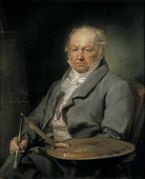Francisco Goya (1746-1828) a famed painter in his own lifetime, Francisco de Goya was born on March 30, 1746, in Fuendetodos, Spain. He began his art studies as a teenager and even spent time in Rome, Italy, to advance his skills. In 1770s, Francisco Goya (1746-1828) began to work for Spanish royal court. In addition to his commissioned portraits of the nobility, he created works that criticized the social and political problems of his era.
Francisco Goya (1746-1828) a famed painter in his own lifetime, Francisco de Goya was born on March 30, 1746, in Fuendetodos, Spain. He began his art studies as a teenager and even spent time in Rome, Italy, to advance his skills. In 1770s, Francisco Goya (1746-1828) began to work for Spanish royal court. In addition to his commissioned portraits of the nobility, he created works that criticized the social and political problems of his era.
Through the German artist Anton Raphael Mengs, Goya started to create works for Spain's royal family. He first painted tapestry cartoons, which were artworks that served as models for woven tapestries, for a factory in Madrid. These works featured scenes from everyday life, such as "The Parasol" (1777) and "The Pottery Vendor" (1779).
In 1779, Goya won an appointment as a painter to the royal court. He continued to rise in status, receiving admission into the Royal Academy of San Fernando the following year. Goya began to establish a reputation as a portrait artist, winning commissions from many in royal circles.
In 1792, Goya became completely deaf after suffering from an unknown malady. Even in his official work, Goya is thought to have cast a critical eye on his subjects. He painted the family of King Charles IV around 1800, which remains one of his most famous works. Some critics have commented that this portrait seemed to be more a caricature than a realist portrait.
With Ferdinand VII now in power, Goya kept his position in the Spanish court despite having worked for Joseph Bonaparte. Ferdinand reportedly once told Goya that "You deserve to be garroted, but you are a great artist so we forgive you." Others in Spain were not so lucky as the king sought to crackdown on liberals who sought to make the country a constitutional state. Despite the personal risks, Goya expressed his dissatisfaction with the Ferdinand's rule in a series of etchings called "Los disparates." These works featured a carnival theme and explored folly, lust, old age, suffering and death among other issues. With his grotesque imagery, Goya seemed to illustrate the absurdity of the times.
The political climate subsequently became so tense that Goya willingly went into exile in 1824. Despite his poor health, Goya thought he might be safer outside of Spain. Goya moved to Bordeaux, France, where he spent the remainder of his life. During this time, he continued to paint. Some of his later works included portraits of friends also living in exile. Goya died on April 16, 1828, in Bordeaux, France.
